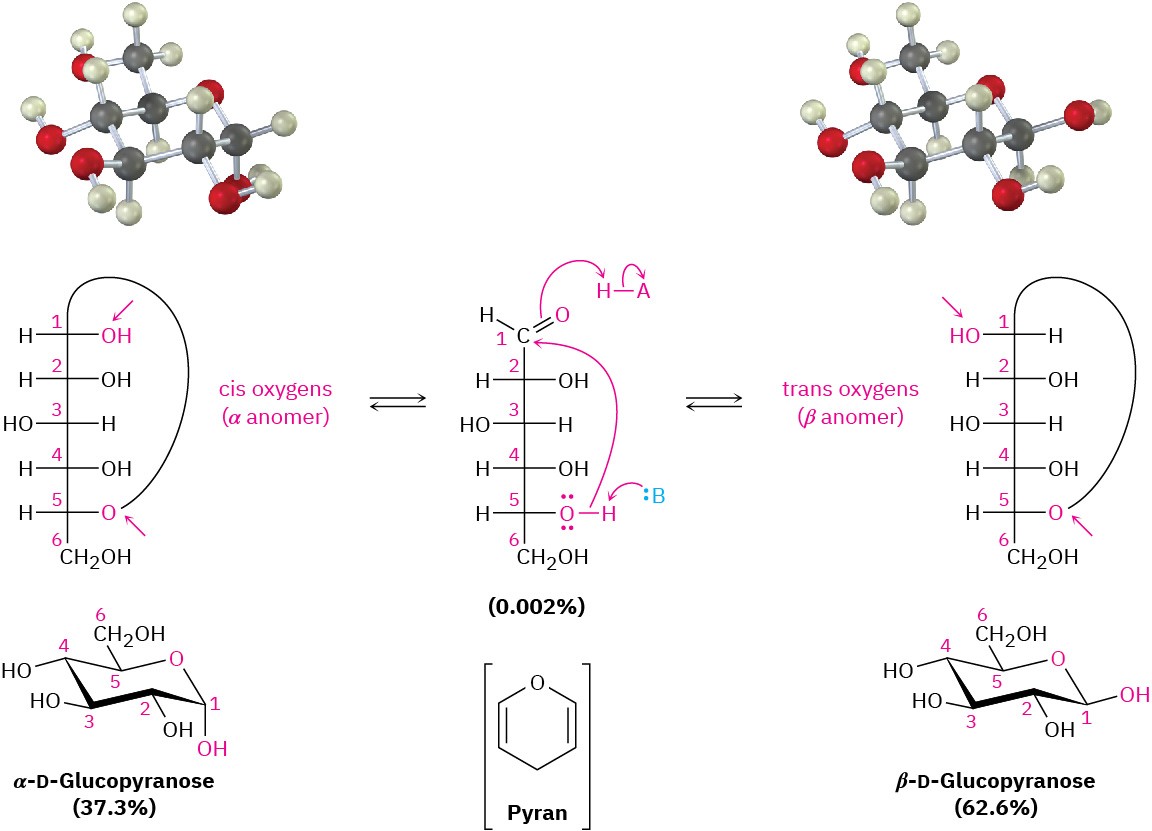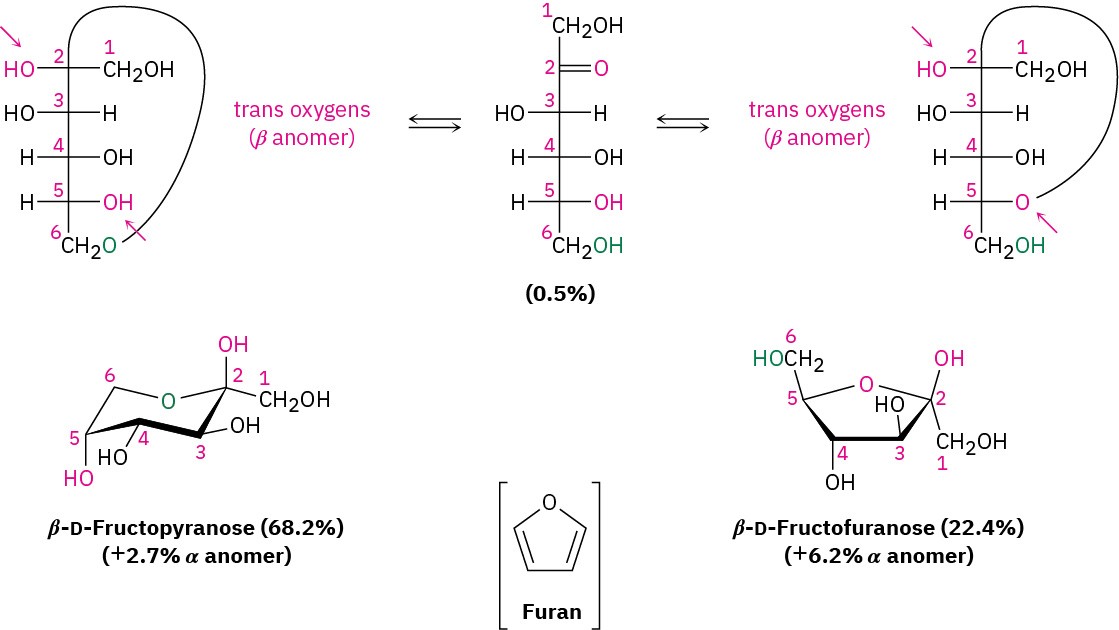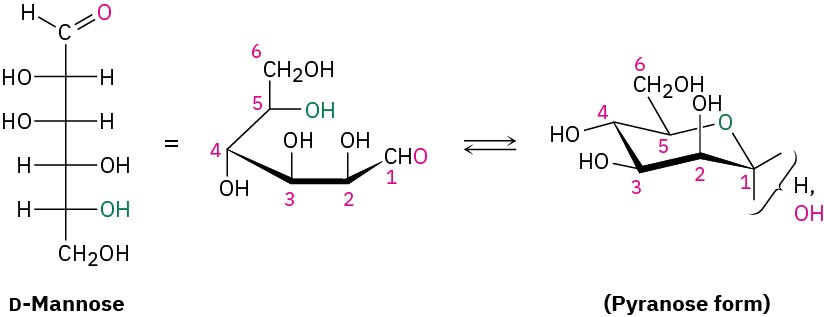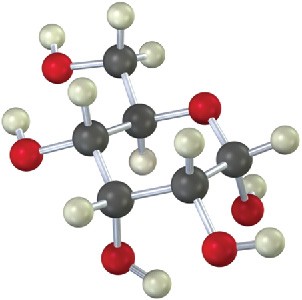25.5 Cyclic Structures of Monosaccharides: Anomers
We said in Section 19.10 that aldehydes and ketones undergo a rapid and reversible nucleophilic addition reaction with alcohols to form hemiacetals.

If the carbonyl and the hydroxyl group are in the same molecule, an intramolecular nucleophilic addition can take place, leading to the formation of a cyclic hemiacetal. Five- and six-membered cyclic hemiacetals are relatively strain-free and particularly stable, and many carbohydrates therefore exist in an equilibrium between open-chain and cyclic forms. Glucose, for instance, exists in aqueous solution primarily in the six-membered pyranose form resulting from intramolecular nucleophilic addition of the –OH group at C5 to the C1 carbonyl group (Figure 25.5). The name pyranose is derived from pyran, the name of the unsaturated six-membered cyclic ether.
Like cyclohexane rings (Section 4.6), pyranose rings have a chairlike geometry with axial and equatorial substituents. By convention, the rings are usually drawn by placing the hemiacetal oxygen atom at the right rear, as shown in Figure 25.5. Note that an –OH group on the right in a Fischer projection is on the bottom face of the pyranose ring, and an –OH group on the left in a Fischer projection is on the top face of the ring. For D sugars, the terminal –CH2OH group is on the top of the ring, whereas for L sugars, the –CH2OH group is on the bottom.
When an open-chain monosaccharide cyclizes to a pyranose form, a new chirality center is generated at the former carbonyl carbon and two diastereomers, called anomers, are produced. The hemiacetal carbon atom is referred to as the anomeric center. For example, glucose cyclizes reversibly in aqueous solution to a 37 : 63 mixture of two anomers (Figure 25.5). The compound with its newly generated –OH group at C1 cis to the –OH at the lowest chirality center in a Fischer projection is called the α anomer; its full name is α-D- glucopyranose. The compound with its newly generated –OH group trans to the –OH at the lowest chirality center is called the β anomer; its full name is β-D-glucopyranose. Note that in β-D-glucopyranose, all the substituents on the ring are equatorial. Thus, β-D- glucopyranose is the least sterically crowded and most stable of the eight D aldohexoses.

Figure 25.5 Glucose in its cyclic pyranose forms. As explained in the text, two anomers are formed by cyclization of glucose. The molecule whose newly formed –OH group at C1 is cis to the oxygen atom on the lowest chirality center (C5) in a Fischer projection is the α anomer. The molecule whose newly formed –OH group is trans to the oxygen atom on the lowest chirality center in a Fischer projection is the β anomer.
Some monosaccharides also exist in a five-membered cyclic hemiacetal form called a furanose. D-Fructose, for instance, exists in water solution as 68% β-pyranose, 2.7% α– pyranose, 0.5% open-chain, 22.4% β-furanose, and 6.2% α-furanose. The pyranose form results from addition of the –OH at C6 to the carbonyl group, while the furanose form results from addition of the –OH at C5 to the carbonyl group (Figure 25.6).

Figure 25.6 Pyranose and furanose forms of fructose in aqueous solution. The two pyranose anomers result from addition of the C6 –OH group to the C2 carbonyl; the two furanose anomers result from addition of the C5 –OH group to the C2 carbonyl.
Both anomers of D-glucopyranose can be crystallized and purified. Pure α-D-glucopyranose has a melting point of 146 °C and a specific rotation [α]D = +112.2; pure β-D-glucopyranose has a melting point of 148 to 155 °C and a specific rotation [α]D = +18.7. When a sample of either pure anomer is dissolved in water, however, its optical rotation slowly changes until it reaches a constant value of +52.6. That is, the specific rotation of the α-anomer solution decreases from +112.2 to +52.6, and the specific rotation of the β-anomer solution increases from +18.7 to +52.6. Called mutarotation, this change in optical rotation is due to the slow interconversion of the pure anomers to give the same 37 : 63 equilibrium mixture.
Mutarotation occurs by a reversible ring-opening of each anomer to the open-chain aldehyde, followed by reclosure. Although the equilibration is slow at neutral pH, it is catalyzed by both acid and base.
 Worked Example 25.4Drawing the Chair Conformation of an AldohexoseD-Mannose differs from D-glucose in its stereochemistry at C2. Draw D-mannose in its chairlike pyranose form.
Worked Example 25.4Drawing the Chair Conformation of an AldohexoseD-Mannose differs from D-glucose in its stereochemistry at C2. Draw D-mannose in its chairlike pyranose form.
StrategyFirst draw a Fischer projection of D-mannose. Then lay it on its side, and curl it around so that the –CHO group (C1) is on the right front and the –CH2OH group (C6) is toward the left rear. Now, connect the –OH at C5 to the C1 carbonyl group to form the pyranose ring. In drawing the chair form, raise the leftmost carbon (C4) up and drop the rightmost carbon (C1) down.Solution

Worked Example 25.5Drawing the Chair Conformation of a PyranoseDraw β-L-glucopyranose in its more stable chair conformation.StrategyIt’s probably easiest to begin by drawing the chair conformation of β-D-glucopyranose. Then draw its mirror-image L enantiomer by changing the stereochemistry at every position on the ring, and carry out a ring-flip to give the more stable chair conformation. Note that the –CH2OH group is on the bottom face of the ring in the L enantiomer, as is the anomeric –OH.Solution

Problem 25-11
Ribose exists largely in a furanose form, produced by addition of the C4 –OH group to the C1 aldehyde. Draw D-ribose in its furanose form.
Problem 25-12
Figure 25.6 shows only the β-pyranose and β-furanose anomers of D-fructose. Draw the α– pyranose and α-furanose anomers.
Problem 25-13
Draw β-D-galactopyranose and β-D-mannopyranose in their more stable chair conformations. Label each ring substituent as either axial or equatorial. Which would you expect to be more stable, galactose or mannose?
Problem 25-14
Draw β-L-galactopyranose in its more stable chair conformation, and label the substituents as either axial or equatorial.
Problem 25-15
Identify the following monosaccharide, write its full name, and draw its open-chain form as a Fischer projection.


